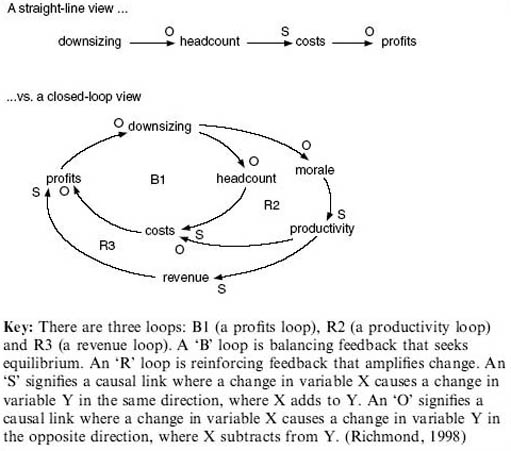Systems dynamics
In the 1950s, Jay Forrester, a systems engineer at MIT, was commissioned by the US company Sprague Electric to study the extreme oscillations of their sales and establish a means to correct them. From previous experience, Forrester knew the essence of the problem stemmed from the oscillations present in situations that contain inertia effects, or delays and reverse effects, or feedback loops as basic structural characteristics.
Subsequently, in 1961, Forrester published his report on industrial dynamics that marked the beginning of the systems dynamics (SD) technique based on the study and simulation of the behaviour of social systems (Martinez, 1993). The experiences of Forrester that gave rise to the development of SD have been investigated in considerable detail by Brian Bloomfield (1986) as part of his PhD research with the Systems Group at the OU. He describes the SD approach as:
[…] building a computer simulation model to describe the behaviour of any particular system under study, followed by experimentation with the model in order to derive suitable policy options for modifying the behaviour of the real system. (p. viii)
Bloomfield does not regard SD as mere technique, but as a systems philosophy because it embodies a theory about the nature of complex feedback systems. This theory holds that people live in a network of feedback structures, incorporating economic, political and ecological subsystems. The feedback structures determine many of the problems – from famine to overcrowding, from inflation and unemployment to ecological collapse – which have caused considerable public concern in recent times (e.g. Figure 44 models unemployment and profit).
Forrester has been and remains (he was born in 1918) a powerful figure in the SD community, which is regarded by many as somewhat closed.
Forrester, an electrical engineer by initial training, spent the years of World War II at MIT where feedback theory was being developed for the control of military equipment. In 1947, Forrester took charge of the MIT digital computer laboratory, which developed one of the first high-speed digital computers. The second phase of Forrester's career began in 1956 when he moved into the field of management science at MIT's Sloan School of Management. At the time, the mathematical approach of operations research was restricted to linear relationships between variables. This was because non-linear relationships could not be solved analytically. In contrast, Forrester advocated a closed-loop approach in which a feedback loop is established between policy output and information input (Bloomfield, 1986, p. 4).
Forrester published World Dynamics in 1968 and this served as a basis for the Meadows and Meadows (1972) report to the Club of Rome entitled Limits to Growth. Francois (1997) suggests the report and the extensive controversy it provoked were actually responsible for popularising systems dynamics. The cultural background as well as some of the methodological assumptions of SD have been heavily criticised (e.g. Flood and Jackson, 1991). Flood (2000), for example, suggests SD-practice is open to criticisms of being imprecise because it relies on extant data and the outputs are potentially very sensitive to initial starting conditions, including assumptions. Many however find it useful.

The initial stages in making an SD model involve the description of ‘the system’, identification of elements and relationships followed by the construction of a causal loop diagram (see Figure 44). SD has also developed its own modelling language and symbols, which are shown in Figure 44. It is argued by some that when engaging with complex situations many SD practitioners can enable participants to learn just as much from the process of developing causal loop diagrams (combinations of influence, multiple-cause and sign graphs – see OpenLearn unit T552 Systems Diagramming) as from the subsequent computer simulations.
